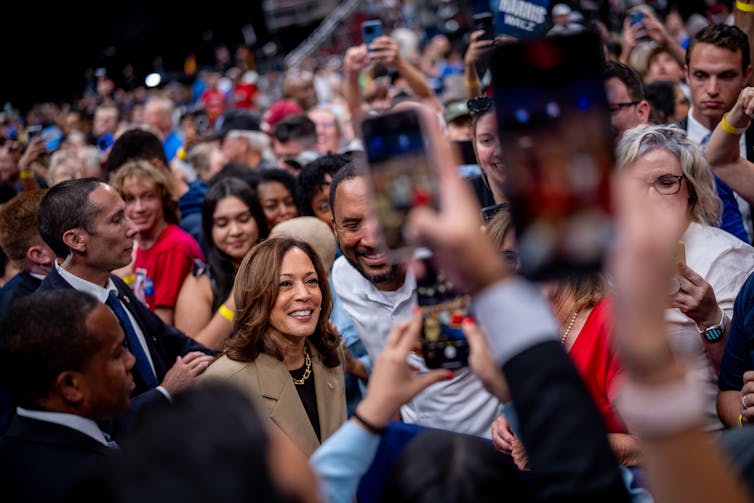Kamala Harris’ sudden political rise echoes that of another female politician, New Zealand’s Jacinda
Jacinda Ardern, like Kamala Harris, unexpectedly became the leader of her political party close to the election. The similarities don’t stop there.

Kamala Harris’ quick, unexpected transformation from a low-profile vice president to the headline-dominating Democratic presidential nominee has upended the 2024 election in just a few short weeks.
Across the Pacific Ocean, Harris’ story may resonate with New Zealanders, like myself, who see parallels with Jacinda Ardern, a young, politically astute liberal, and her sudden rise to her party’s leadership in 2017. Ardern’s swift ascension disrupted the foregone conclusion that her political party was headed for a decisive defeat in an upcoming election.
Since President Joe Biden announced on July 21, 2024, that he would not run for reelection, Harris closed the gap in at least one major poll between Biden and Republican contender Donald Trump. Harris also brought in a surge of donations and volunteer sign-ups, won support from 99% of Democratic National Committee delegates and has been lauded for injecting joy into the campaign and for giving Democratic voters hope.
Ardern, similarly, became the leader of her party and a prime minister contender after New Zealand’s Labour Party leader Andrew Little, 52, saw no pathway to victory and stepped aside just seven weeks before the September 2017 election.
Ardern’s 11th-hour promotion gave the campaign a jolt of energy and infused it with what Ardern called “relentless positivity.” Ardern quickly unified her party and ultimately, when the votes were counted and a coalition formed, landed the top job as prime minister.
Ardern’s whirlwind campaign and tenure also shows some pitfalls other women leaders, like Harris, might face, including being compelled to appear as competent and likable while fending off hateful attacks.

No pathway ahead
In the first few months of 2017, it seemed like the center-right National Party in New Zealand would win reelection after nine years leading the government.
After months of dismal poll results, Little, the Labour Party leader, believed his party would lose the election.
Little also trailed his deputy leader, Ardern, in preferred prime minister polls – despite Ardern’s repeated declarations that she did not want to be prime minister.
Little resigned on July 31, 2017. Within hours, Labour politicians unanimously nominated Ardern as their replacement leader.
Ardern, then 37, accepted the nomination. She promised that she and her team would be “positive, organized and ready.” She gave herself three days to overhaul the campaign.
A campaign of unity
By connecting with voters and focusing on positivity, Ardern’s short campaign united a party known for fractious infighting.
What followed might seem familiar to many people closely following American politics today. Ardern kicked off her campaign with a photo of her smiling, captioned: “Let’s Do This.” She held lively campaign rallies across the country. And the public responded.
As a culture, we New Zealanders often avoid exuberance. So, the phenomenon of “Jacindamania” was remarkable.
Crowds swarmed for selfies with Ardern. Ardern’s face was plastered on merchandise and showed up in political memes across social media.
Donations and volunteer sign-ups to the Labour Party surged. So, too, did donations to the opposing National Party, as Ardern had sparked a genuine competition.
A common message of joy
As a prime minister candidate, Ardern embraced and promoted her brand of “relentless positivity,” as she put it.
The opposition tried to depict her as inexperienced and superficial and then launched attack ads – milder than what U.S. voters expect to see in a political campaign, but a rarity in New Zealand politics.
The attacks did little to dispel Ardern’s stardust. If anything, the jabs stood in contrast to her positive messaging. Ardern’s Facebook Lives with supporters were consistently upbeat. Her interviews and press conferences combined charm with detailed policy knowledge.
It seems “relentless positivity” landed with New Zealanders on the strength of Ardern’s charisma. Her opponent, in his own words, “specialized in being boring.” A prominent journalist wrote of a “mood for change,” despite the economy being strong overall by most measures, a housing crisis notwithstanding.
Harris’ early polling gains against Trump suggest a similar story. The sexist and racist attacks against Harris appear to be largely falling flat, at least so far.
Instead, memes and clips of Harris dancing, laughing and speaking to large crowds of supporters have gone viral.
Harris, responding to Trump’s attacks, has dismissed him as “the same old show.”
Evolving gender politics
Gender stereotypes still play a role in voters’ perception of leaders. Both Democratic and Republican women politicians are perceived as more liberal than their male counterparts. Yet also, in a study of 35 countries – including New Zealand but not the U.S. – women-led parties are seen as “less extreme.”
Both Ardern and Harris are liberals with relatively moderate voting records. Trump’s attempts to cast Harris as a “radical left lunatic” do not square with her former prosecutor credentials and overtures to corporations.
Ardern’s advantage, meanwhile, was that she attracted both centrist voters and those further to the left. She did this by making kindness and positivity central features of her campaign, while also making controversial calls, such as coming out against tax reform, which frustrated some hoping for more progressive leadership.
Harris may also have opportunities to win both centrist voters and offer a better alternative to Trump.

Lessons for American voters
Should Harris succeed in her presidential bid, Ardern’s experience provides a note of caution.
Ardern was targeted by unprecedented degrees of violent hate speech, misogyny and death threats. These worsened throughout her leadership and peaked during an April 2022 violent occupation of Parliament by protesters who wanted to end the country’s COVID-19 restrictions.
By 2023, Ardern’s support had dropped, forecasting her party’s ouster from leadership.
Disinformation researcher Kate Hannah suggested that violent speech against Ardern may have contributed to her decision to resign in January 2023. At the time, Ardern said, “I know what this job takes, and I know that I no longer have enough in the tank to do it justice.”
Republicans’ attacks on Harris may, for now, be less effective with less time to embed themselves in voters’ minds. But attacks tend to accrue over time.
Ardern’s last-minute rise to leadership may give some Democrats an example to consider as they look to November. But Ardern’s story offers reasons for trepidation for those who hope for less malicious politics.
Lydia Nobbs does not work for, consult, own shares in or receive funding from any company or organization that would benefit from this article, and has disclosed no relevant affiliations beyond their academic appointment.
Read These Next
The Supreme Court’s decision on birthright citizenship will depend on its interpretation of one phra
Advocates for each side will provide a different explanation for who falls under ‘the jurisdiction’…
Hope and hardship have driven Syrian refugee returns – but many head back to destroyed homes, land d
A quarter of the 6 million Syrians who fled the country during the decadelong civil war have returned…
Pete Hegseth could be investigated for illegal orders by 5 different bodies – but none are likely to
Allegations are swirling around a US military strike on an alleged drug boat that resulted in 2 civilian…





